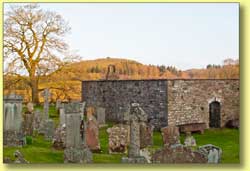Mysterious death of Robert Kirk on Doon Hill the home of the fairies
Aberfoyle (Scottish Gaelic: Obar Phuill) is a village that lies inside the Lomond & Trossachs National Park (Scottish Gaelic: Pàirc Nàiseanta Loch Laomainn is nan Tròisichean). Seen as a gateway to the Trossachs, Aberfoyle is situated on the River Forth (Abhainn Dubh) at the foot of Craigmore. Loch Ard (Loch na h-Àirde) , Loch Chon, Loch Arklet and Loch Lomond (Loch Laomainnare) to the West, Loch Katrine (Loch Ceiteirein), Loch Achray and Loch Venachar (Loch Bheannchair) to the North and the Lake of Menteith (Loch Innis Mo Cholmaig), to the East. The village is an attractive place to visit with a number of connections to historical figures. One of the most famous being the Reverend Robert Kirk,
Robert Kirk (9 December 1644 – 14 May 1692) was a minister, Gaelic scholar and folklorist. He was the seventh son of the minister of Aberfoyle. He went on to study theology and eventually became minister of Aberfoyle, from 1685 until his death in 1692. He is noted for providing the first translation to Gaelic of the book of Psalms, published at Edinburgh in 1684 as Psalma Dhaibhidh an Meadrachd, &c. He also helped in one of the first publications of the bible into Scottish Gaelic. However, it was for another work, The Secret Commonwealth, and the stories that surround his death that he is now best remembered. Robert Kirk had an interest in the supernatural, fairies, folk beliefs, second sight and traditional stories and beliefs held by the people of the Scottish Highlands. He collected and wrote about these tales in around 1691, although his work was not published in his lifetime. They were released by Scottish author Walter Scott in 1815, then later a second edition was published in 1893, under the title The Secret Commonwealth of Elves, Fauns and Fairies.
His research involved investigating the strong belief held by the Gaelic peoples in the supernatural world of fairies and creatures of the Otherworld. While many in the Church strode to suppress such beliefs without success, the Reverend Robert Kirk did not condemn those who believed in the supernatural. The Celtic people held firmly to their superstitions as many still do today. He sought to investigate and learn about them. He believed the Sleagh Maith or fairies was a fact in nature, that could be investigated as a matter of scientific enquiry and could be incorporated into the Christian faith. In his research he collected several personal accounts and stories of those who claimed to have encountered them. He wrote: ‘These Siths or Fairies they call Sleagh Maith or the Good People … are said to be of middle nature between Man and Angel, as were Daemons thought to be of old; of intelligent fluidous Spirits, and light changeable bodies (lyke those called Astral) somewhat of the nature of a condensed cloud, and best seen in twilight. These bodies be so pliable through the sublety of Spirits that agitate them, that they can make them appear or disappear at pleasure.’ It was after this, that Robert Kirk, minister of Aberfoyle parish, died in unusual circumstances.
Robert Kirk concluded that the Sithe, lived in caverns under Dun Sithean or Doon Hill which is close to the village of Aberfoyle. Also, that located on Doon Hill was the gateway to the "Secret Commonwealth", the domain of the Fairies. The fairy folk could be seen on the first Sunday of every quarter year by those with the gift of second sight. Robert Kirk took regular walks to Doon Hill. It was said that the minister would spend time lying on the Hill with his ear to the ground, listening for the sound of fairy activity. One evening on the 14th May 1692 his body was found lying, seemingly dead, on the hill. Local stories tell of him having fallen into an unconscious state and the fairies of Doon Hill had carried off his soul. They were said to have been angry with him for his over attentive interest in their activities and secret domain. A funeral took place and a tomb erected on the south side of Kirkton Church graveyard. There is a large pine tree that remains standing at the top of Doon Hill which is said to contain Robert Kirk's imprisoned spirit.
Robert Kirk’s wife was pregnant at the time of his loss. Another story is that the ghost of Robert Kirk had appeared to a relative. The ghost said that he had indeed been carried off by the fairies. However, he said that he would appear at the baptism of his child. Whereupon if Robert Kirk's cousin, Graham of Duchray, saw the ghost he was to throw an iron knife at the apparition. This would free Robert Kirk from being in the Fairies' possession. However, when the spectre appeared Graham was too shocked by the vision to throw the knife, and Robert Kirk's ghost faded away never to be seen again.
Visitors still climb Doon Hill to this very day and write their wishes on pieces of white silk or cloth, tieing them to the branches of the trees for the Fairies to grant. The tree is often referred to as the 'Minister's Pine' tree.

- Douglas MacQueen's blog
- Log in to post comments





